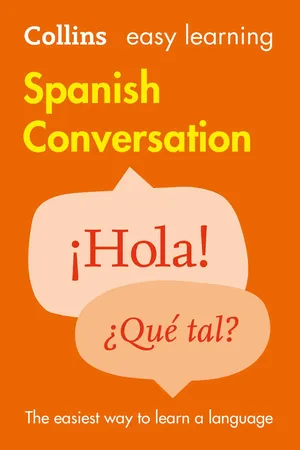
eBook - ePub
Easy Learning Spanish Conversation
This is a test
- English
- ePUB (mobile friendly)
- Available on iOS & Android
eBook - ePub
Easy Learning Spanish Conversation
Book details
Book preview
Table of contents
Citations
Frequently asked questions
How do I cancel my subscription?
Can/how do I download books?
At the moment all of our mobile-responsive ePub books are available to download via the app. Most of our PDFs are also available to download and we're working on making the final remaining ones downloadable now. Learn more here.
What is the difference between the pricing plans?
Both plans give you full access to the library and all of Perlego’s features. The only differences are the price and subscription period: With the annual plan you’ll save around 30% compared to 12 months on the monthly plan.
What is Perlego?
We are an online textbook subscription service, where you can get access to an entire online library for less than the price of a single book per month. With over 1 million books across 1000+ topics, we’ve got you covered! Learn more here.
Do you support text-to-speech?
Look out for the read-aloud symbol on your next book to see if you can listen to it. The read-aloud tool reads text aloud for you, highlighting the text as it is being read. You can pause it, speed it up and slow it down. Learn more here.
Is Easy Learning Spanish Conversation an online PDF/ePUB?
Yes, you can access Easy Learning Spanish Conversation by in PDF and/or ePUB format, as well as other popular books in Langues et linguistique & Langue espagnole. We have over one million books available in our catalogue for you to explore.
Information
Small talk
¿Qué tal? – How are things?
Whether you’re going to be working in a Spanish-speaking country or spending some time with your Spanish-speaking friends, you’ll want to be able to chat with people and get to know them better. The phrases in this unit will help you communicate with acquaintances, friends, family and colleagues in a variety of everyday situations.
GREETINGS
To get you off on the right footing, you need to know how to say hello to people properly. Just as in English, there are several ways of doing this in Spanish. You can simply use hola (hello or hi) on its own. You can also use buenos días (good morning), buenas tardes (good afternoon or good evening – provided it’s still light), and buenas noches (good evening – once it’s dark). Spanish-speakers often use both together, as in hola, buenos días and hola, buenas tardes.
Hello
| Hola. | Hello. |
| ¡Hola, Jaime! | Hi Jaime! |
| Buenos días. | Good morning. |
| Hola, buenos días. | Good morning. |
| Buenas tardes, Luis. | Good afternoon, Luis. |
| Buenas noches. | Good evening. |
¿LO SABÍAS?
When you pass friends and acquaintances in the street and don’t stop to talk, rather than saying hola you say hasta luego or adiós.
You’ll also want to ask the people you know how they are. The simplest way to do this is by using ¿Qué tal? This is quite informal, and suitable when you know the person quite well. If you want to be more formal you say ¿Cómo está? to someone you speak to as usted.
How are you?
| Hola, Juana, ¿qué tal? | Hi, how are you, Juana? |
| ¡Buenos días! ¿Cómo está, señor García? | Good morning! How are you, señor García? |
| Hola, Pepe, ¿qué tal te va? | Hello, Pepe, how’s it going? |
| ¿Qué pasa, Raquel? ¡Cuánto tiempo sin verte! | How are things, Raquel? It’s ages since I’ve seen you! |
Use adiós (goodbye) or hasta pronto (see you soon) to say goodbye to people you don’t know well. You can just say hasta luego (see you) if you want to sound more informal.
Goodbye
| ¡Adiós! | Goodbye! |
| ¡Adiós! ¡Hasta otra! | Goodbye! See you again! |
| ¡Buenas noches! | Good night! |
¿LO SABÍAS?
Buenas noches means both good evening and good night. So you use it both when arriving and leaving somewhere in the evening. When saying goodbye to someone you know you’ll see tomorrow, such as a colleague, you say hasta mañana (see you tomorrow).
See you…!
| ¡Hasta luego! | See you! |
| ¡Hasta pronto! | See you soon! |
| ¡Hasta ... |
Table of contents
- Title page
- Copyright
- Contents
- Introduction
- Spanish pronunciation
- Units
- Grammar
- Verb tables
- Vocabulary builder
- About the publisher